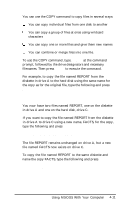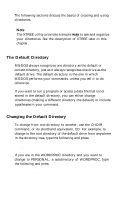Epson Apex 200 User Manual - Page 87
Printing Files, Are you sure Y/N?, PRINT A:STATS.NBA
 |
View all Epson Apex 200 manuals
Add to My Manuals
Save this manual to your list of manuals |
Page 87 highlights
You can use wildcards to delete groups of files. For example, to delete all files on the diskette in drive A (in the current directory), type the following and press Enter: DEL A:*.* Because deleting all files is a serious procedure, MS-DOS prompts you to confirm the command when you use the * . * wildcard combination with the DEL command. You see this prompt: Are you sure (Y/N)? Press Y for yes or N for no. A synonym for DEL is ERASE. Thus, you can substitute ERASE for DEL in any of the preceding examples. Printing Files If you have a printer attached to your computer, you can print files with the PRINT command. You will probably be printing files with the application programs you use with MS-DOS, but if you need to print a file from the MS-DOS command prompt, follow the steps below. To print a file named STATS.NBA from the diskette in drive A: 1. Make sure your printer is on and ready to print. 2. At the command prompt, type the following and press Enter: PRINT A:STATS.NBA MS-DOS prompts you for the name of the printing device connected to your computer. (This is usually the name of the communications port that the printer cable is connected to, such as PRN.) Using MS-DOS With Your Computer 4-15















